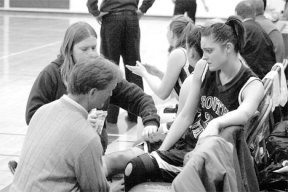No question, it was an anxious moment for everyone present when senior Marcella Litwiller crashed to the floor in the third quarter of the Lady Falcon’s first basketball playoff game at Shore-crest High School Feb. 14.
But now was the time for Jim Christensen to come off the bench.
The school’s physical therapist and sports medicine teacher for the past six years, Christensen is on hand for most games, home and away.
“The first thing we did was to assess her injury on the floor,†Christensen explained. “Then we had to decide whether to move Marcella to the bench. We used ice and pressure to compress her right knee and helped her walk a bit to see if her leg could take the weight.â€
Then came a tough call.
“It couldn’t and I would not let her back in the game,†he said. Marcella’s parents concurred.
“At that point, we sent her to a local hospital and then home.â€
Later, it was determined she had a serious hamstring injury.
Christensen has from 200 to 500 treatment sessions per season, ranging from sprains and abrasions to more serious bone injuries.
And though football and soccer injuries can be serious, most problems are related to track and cross country. “Running problems are not as serious, but they’re persistent,†Christensen said.
He’s found that girls play as hard as boys but their bodies don’t handle stress as well.
“We see a lot of knee injuries from girls,†he said.
Track coach Doug Fulton concurs.
“Jim and his program have been an extremely valuable asset to both the cross country and track and field programs,†Fulton said. “He has supplied preventative care and rehab to many of our athletes enabling them to return to running or throwing much sooner than they would have otherwise. He is indeed an integral part of our sports programs at South Whidbey.â€
Christensen noted that he doesn’t want kids to develop arthritic conditions at age 45 as a result of traumatic injuries they received when they were young.
“The more information we can impart in the classroom and through student trainers on site, the less chance for long-term repercussions,†he said.
Christensen isn’t the only person on the sidelines worried about keeping South Whidbey athletes healthy.
With an eye to exposing young people to future medical careers, the school’s sports medicine program offers students the chance to study the care, prevention and evaluation of athletic injuries; basic first aid; medical terminology; basic emergency trauma situations; mechanisms of injury, rehabilitation, human anatomy and other topics related to health occupations.
Students are trained to assist athletic teams and their coaches, and can spend equal amounts of time in the classroom and/or in an internship on athletic venues, earning one classroom credit and one work experience credit.
Senior Amanda LaVassar took it as a freshman course and became a player-trainer for the basketball team.
“At first I thought it would be fun, then realized it was interesting and I could be of help to other athletes,†she said.
“I do the initial work up if there’s an injury and taping if necessary,†LaVassar said.
She also volunteers four hours a week at Christensen’s clinic in Clinton.
Junior Rhonda Johnson first took training in physical therapy in October 2004 and decided she wanted to pursue it.
“I love doing this,†she said.
At every game she carries a bag of supplies with hydrogen peroxide, tape and swabs, Band-Aids, Skin Shield, mouth barriers, salves and lotions. But it hasn’t always been the easy choice.
During a wrestling match last year, then-senior Nik Rueth dislocated his left elbow and shattered both lower arm bones. Paramedics arrived and tried to apply an air-cast but it caused terrible pain.
Rueth was finally sent to the emergency room.
“It was the worst thing I’d ever seen,†Johnson recalled.
Despite that, Johnson plans to continue her interest in physical therapy past high school.
Christensen began his career with the Navy as a corpsman in Philadelphia, working with Marines just back from Vietnam.
He was motivated to continue in the medical field, following up with a degree in physical therapy from Fresno State before moving to Seattle in 1981.
In 1986 he began Family Care Clinics in Freeland, Clinton and Oak Harbor, and was hired by South Whidbey in 2000.
Classes typically have 20 to 25 students plus an after-school advanced program for 10 others interested in sports medicine.
“Quite a few have gone on to medical-related study in college. And for a few, like Rhonda, there’s the chance to study and become an employee,†Christensen said.
Through the year, he has guest speakers come in to talk to students about a wide range of topics: chiropractic medicine, nursing and naturopaths. Last week, a doctor discussed venom in treating snake bites.
Christensen is quick to point out that his program is a small part of the vocational career opportunities offered at the high school.
But he also has discovered something else.
“I get back 10 times more than what I put into this. My life has changed dramatically since I started teaching here,†he said.
The whole process seems to work.
At his clinic, Christensen taught Litwiller a series of range and motion exercises to help get her moving again, at no charge. Her leg healed sufficiently to let her play in the girls final playoff game in Bellingham on Feb. 21, where she contributed nine points and nine rebounds.
“These athletes put out 100 percent,†Christensen said. “Sometimes they get hurt and that’s why this program exists.â€



